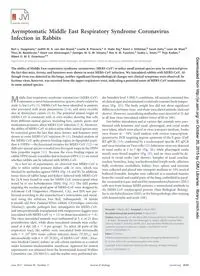
2015 Asymptomatic Middle East Respiratory Syndrome Coronavirus Infection in Rabbits PDF
Preview 2015 Asymptomatic Middle East Respiratory Syndrome Coronavirus Infection in Rabbits
Asymptomatic Middle East Respiratory Syndrome Coronavirus Infection in Rabbits Bart L. Haagmans,a Judith M. A. van den Brand,a Lisette B. Provacia,a V. Stalin Raj,a Koert J. Stittelaar,b Sarah Getu,a Leon de Waal,b Theo M. Bestebroer,a Geert van Amerongen,a Georges M. G. M. Verjans,a Ron A. M. Fouchier,a Saskia L. Smits,a,b Thijs Kuiken,a Albert D. M. E. Osterhausa,b Department of Viroscience, Erasmus Medical Center, Rotterdam, the Netherlandsa; Viroclinics Biosciences, Rotterdam, the Netherlandsb The ability of Middle East respiratory syndrome coronavirus (MERS-CoV) to infect small animal species may be restricted given the fact that mice, ferrets, and hamsters were shown to resist MERS-CoV infection. We inoculated rabbits with MERS-CoV. Al- though virus was detected in the lungs, neither significant histopathological changes nor clinical symptoms were observed. In- fectious virus, however, was excreted from the upper respiratory tract, indicating a potential route of MERS-CoV transmission in some animal species. M iddle East respiratory syndrome coronavirus (MERS-CoV) represents a novel betacoronavirus species closely related to clade 2c bat CoVs (1). MERS-CoV has been identified in patients who presented with acute pneumonia (2–4), and more recently also in dromedary camels (5, 6). The potential animal origin of MERS-CoV is consistent with in vitro studies showing that cells from different animal species, including bats, camels, goats, and nonhuman primates, allow MERS-CoV infection (7, 8). However, the ability of MERS-CoV to infect some other animal species may be restricted given the fact that mice, ferrets, and hamsters were shown to resist MERS-CoV infection (9–11). Detailed analysis of the MERS-CoV spike protein binding region in dipeptidyl pepti- dase 4 (DPP4)—the functional receptor for MERS-CoV (12)—in different animal species revealed two divergent loops in the DPP4 beta propeller region (11). Because the virus binding region in rabbit DPP4 closely resembles that in human DPP4 (11), we tested whether rabbits can be infected with MERS-CoV. In a first set of experiments, we observed that MERS-CoV is able to infect rabbit primary kidney cells in vitro, which was blocked by antibodies against DPP4 (Fig. 1A and B). In addition, tissue slices of rabbit lungs and kidney infected with MERS-CoV for 24 h were found to stain for MERS-CoV nucleocapsid when tested by in situ hybridization (ISH) (Fig. 1C). The ISH probes targeting the nucleocapsid gene of MERS-CoV were designed by Advanced Cell Diagnostics (Hayward, CA), and ISH was per- formed according to the manufacturer’s instructions and visual- ized using the substrate Fast Red. Subsequently, 16 female 6-month-old New Zealand White rabbits (Oryctolagus cuniculus [Harlan]), specific pathogen free, seronegative for MERS-CoV, and intraperitoneally transplanted with temperature loggers were inoculated with MERS-CoV (n � 12) or sham inoculated (n � 4). The virus-inoculated animals were euthanized at 3, 4, or 21 days postinfection (dpi), while sham-inoculated animals were eutha- nized at 4 dpi (all n � 4 per group). To infect all parts of the respiratory tract, the rabbits were inoculated both intranasally with 1 � 106 50% tissue culture infective doses (TCID50) and intratracheally with 4 � 106 TCID50 of MERS-CoV (EMC [Eras- mus Medical Center] isolate) or cell culture medium as a control under ketamine-medetomidine anesthesia. Approval for animal experiments was obtained from the Institutional Animal Welfare Committee (no. 201300121), and the studies were performed un- der biosafety level 3 (BSL3) conditions. All animals remained free of clinical signs and maintained a relatively constant body temper- ature (Fig. 1D). The body weight loss did not show significant differences between virus- and sham-inoculated animals (data not shown). However, neutralizing antibodies were detected at 21 dpi in all four virus-inoculated rabbits (titers of 80 to 160). Just before inoculation and at various dpi, animals were anes- thetized with ketamine and nasal, pharyngeal, and rectal swabs were taken, which were placed in virus transport medium. Swabs were frozen at �70°C until analysis with reverse transcription- quantitative PCR targeting regions upstream of the E gene (UpE RT-qPCR) (13), confirmed by a nucleocapsid-specific RT-qPCR and virus titration on Vero cells (12). Infectious virus was detected in nasal swabs at 1 to 7 dpi (Fig. 1E), while pharyngeal swabs mostly were found negative (Fig. 1F), and no virus could be de- tected in rectal swabs (not shown). Samples of nasal conchae, trachea, bronchus, lung, tracheobronchial lymph node, olfactory bulb, cerebrum, cerebellum, kidney, liver, spleen, and intestine were collected and placed into transport medium or 10% neutral buffered formalin. Samples were collected in a standard manner from the cranial and caudal parts of the lung, embedded in paraf- fin, sectioned at 4 �m, and used for immunohistochemistry (IHC) with sera from human MERS patients, a monoclonal antibody to the MERS-CoV nucleocapsid protein (Sino Biological, Beijing), for in situ hybridization (ISH), or for histopathology after staining with hematoxylin and eosin (HE). Received 12 March 2015 Accepted 13 March 2015 Accepted manuscript posted online 25 March 2015 Citation Haagmans BL, van den Brand JMA, Provacia LB, Raj VS, Stittelaar KJ, Getu S, de Waal L, Bestebroer TM, van Amerongen G, Verjans GMGM, Fouchier RAM, Smits SL, Kuiken T, Osterhaus ADME. 2015. Asymptomatic Middle East respiratory syndrome coronavirus infection in rabbits. J Virol 89:6131–6135. doi:10.1128/JVI.00661-15. Editor: S. Perlman Address correspondence to Bart L. Haagmans,
